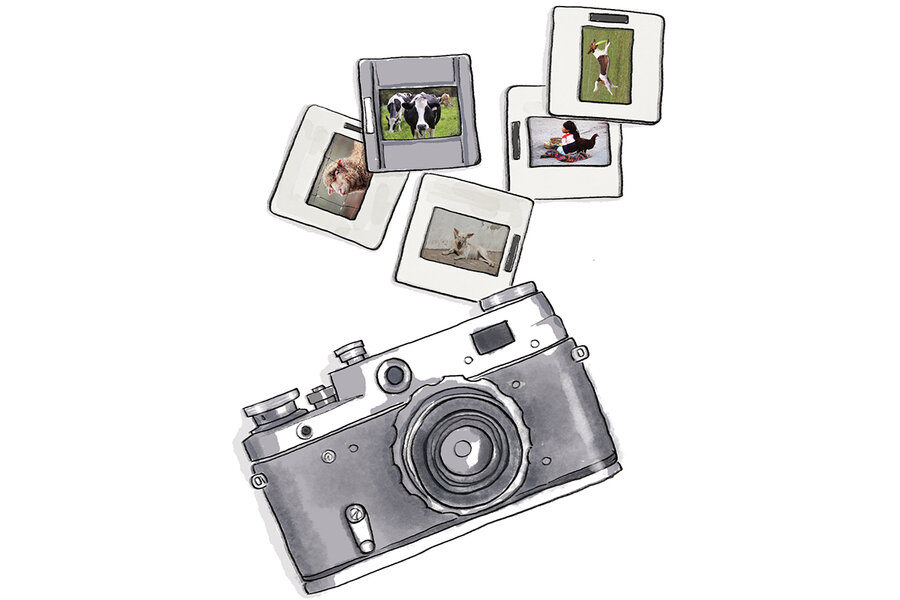Aunt Ruth’s photo philosophy
Loading...
My great-aunt Ruth did not look the part of an adventurer. With her white hair, ever tightly pinned into a coil, conservative button-up blouses, and long skirts, she looked every bit the schoolmarm she was, teaching primary grades for decades in Niagara Falls, New York. Visiting her in my youth meant dinner at 4 p.m. sharp, Paul Harvey on the radio, and meticulous attention to her small garden plot, where she recorded in her diary every bean plucked from the vine. It was hard to imagine her anywhere else but at her kitchen window.
Yet, as a retiree, Ruth boarded the Queen Elizabeth several times and explored Europe, largely on her own – no small undertaking for a single woman in the 1950s. She simply loved to travel, once she was able to.
Aunt Ruth always came to our home after these ventures with a slideshow. My father erected the screen in the family room, and the projector whirred to life, exposing every speck of dust in that room. We kids sprawled on the carpet as Mom, Granddad (Ruth’s brother-in-law), and Ruth took to the easy chairs. Dad clicked the button on the projector’s remote, and we were all abroad, sort of.
There were lovely scenic views of the towns and countryside of Italy and, I think, Austria. The rest of the frames were of animals she’d encountered: street dogs, cats, chickens, squirrels, more dogs, and cows at pasture with mountain backdrops – it might have been Colorado. Granddad mumbled about wasted film. My parents remained polite, though slides were sometimes upside-down, out of focus, or washed out. Back then, you took your exposed film to the local processor and hoped for the best.
I loved those slides. They evoked a side of this aunt I hadn’t known existed, and I also adored the animals she found so worthy of capturing on film. I would bend my head to the side (upside-down, too), squint, and hope for more even as the rack of cardboard frames came full circle.
And then – a must – Dad would switch the projector bulb off and leave the fan going for a few minutes. I later heard this was wholly unnecessary, that the hot bulb would not explode for lack of air circulation. But back then every projector owner I knew adhered to the protocol, a whirring finale thought to prolong the life of what was a pretty expensive bulb.
I hadn’t thought of those slides in years, but after retiring from dairy farming, I returned to my own travel lust, going back to favorite places in Europe, exploring the national parks of Utah, California, and Arizona, discovering New Zealand – and, most recently, beautiful little Ajijic, on Lake Chapala in Mexico.
In Ajijic, I took some lovely photos of the lake at sunset, of the little town’s colorfully decorated cemetery during the nation’s Day of the Dead celebrations, of the flowered cobblestone streets, wall murals, and tortillerias open-fronted to the street. Animals, too: street dogs seated comfortably in restaurant booths, where they are often welcomed and fed; cats lolling on warm tile roofs; roosters strutting across courtyards; hummingbirds, monarch butterflies, and wild pelicans, starkly white against the lake’s hyacinth-green under blue, blue skies. Frame after frame of horses galloping up cobblestone streets and prancing down beaches. I zipped them off to my siblings without thinking, as I had done with photos of Swiss cows, New Zealand sheep, whales, seals, penguins, and birds.
I still have the old family projector and have only had to replace that bulb once in the past 40-some years. Leaving the fan on to cool it must have been the right thing to do, after all.
My grandson became enamored of my own wall-projected slideshows at a very young age, agog at the arcane aura of it all, the magic of non-digital scenes from my travels before the dairy years: rain forests in Puerto Rico, the marine life and geology of the Bahamas, and, yes, Switzerland – slides that often enough feature cows.
After my trip to Mexico last fall, my sister finally leveled with me: “You know, Sue, you have become Aunt Ruth.”
I believe she’s right. And, like Dad, when I show those old slides, I’ll always leave the fan on for a minute or two after switching off the projector bulb.







